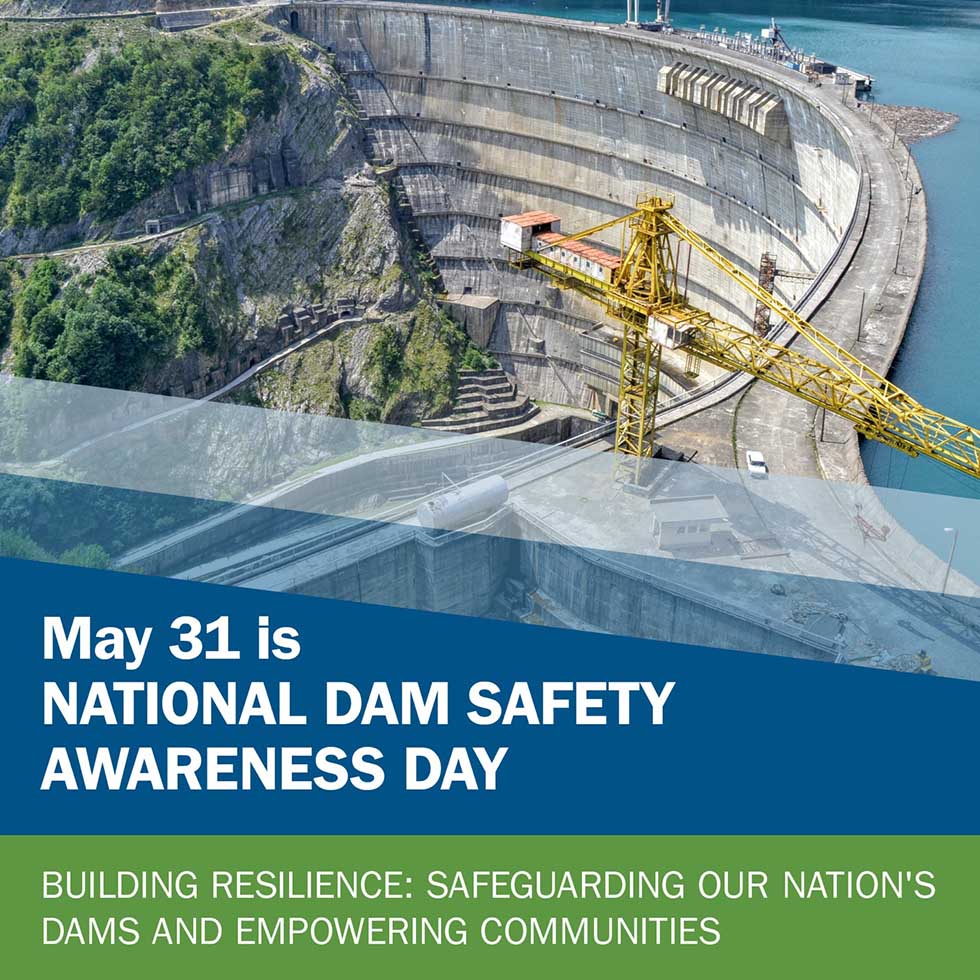
This page has not been translated into Afrikaans. Visit the Afrikaans page for resources in that language.
National Dam Safety Awareness Day

National Dam Safety Awareness Day seeks to encourage and promote individual and community responsibility and best practices for dam safety, as well as what steps can be taken to prevent catastrophic dam failures. The theme for National Dam Safety Awareness Day 2024 on May 31, is, " Building Resilience: Safeguarding Our Nation's Dams and Empowering Communities."
Datum: May 31, 2024
Important Date
Event Details
Dam Safety Awareness Day on May 31 every year is in memoriam of the 2,220 people who lost their lives in the 1889 South Fork Dam failure near Johnstown, Pennsylvania. The collapse of the South Fork Dam was a tragedy and is not an isolated incident. As we observe and reflect on the South Fork Dam tragedy 133 years later, we encourage you to understand the continued importance of dam safety, the roles various parties play, current issues, and why investment in this infrastructure is urgently needed.
Recent crises following heavy seasonal rains, like the failure of the Oroville Dam spillway in California (2017) or the failure of the Edenville and Sanford dams in Michigan (2020), have made major headlines, highlighting the poor condition of many of the nation's dams. Proper maintenance, routine inspection, necessary upgrades, and implementation of an Emergency Action Plan can ensure optimal conditions, protecting public health, safety, and welfare.
National Dam Safety Awareness Day not only commemorates the past, it calls us to action. Make a difference in your community and join FEMA in support of National Dam Safety Awareness Day on May 31.
Get Involved
- Event planning checklist – A list of things to consider when planning your local dam safety event.
- Key messages – A list of short talking points to help start conversations about dam safety.
- Template news release – A pre-approved news release with standard boilerplate language for use by local champions in promoting National Dam Safety Awareness Day. Also included is guidance for engaging members of the media.
- Web and social media content – Suggested content for promoting local events on your website complemented by sharing your stories and/or photos with us by using the #NDSAD hashtag on Facebook, Twitter, Instagram, and LinkedIn.
- Activities for kids – FEMA has prepared a list of suggested activities for engaging children, which helps kids to be more risk-aware. It is also a good way to engage their parents and other family members.
Activity & Curriculum Ideas
Activities
Activity Sheet
- Color in your own Beaverly, Truth or Myth Dam Facts, Maze (show water going through a dam to provide electricity), and Word search/Crossword (can highlight any terminology we want to advocate for)
- Resources:
- FEMA Fact Sheet National Dam Safety Awareness Day – Outreach Ideas for Children
- Association of State Dam Safety Officials – Kids Activities & Links
- Dam Safety with Beaverly: FEMA has created the Dam Safety with Beaverly coloring book to help you and your children or young students learn more about dams and how to stay safe around them
Low-Head Dam Demonstration
- This would break down low-head dam models into a step-by-step "recipe" that could be recreated in their classroom.
- Emphasizes the importance of empowering schools to conduct their dam safety projects and highlights the scalability and ease of implementation of this concept, while making dam safety education more engaging and accessible.
- These potential audiences include recreationists, homeless communities, kayakers, and boaters. A product could be a Low-Head Dam Pocket Guide.
Targeting Different Audiences Campaign
- State or local: Project or grant award ceremonies, training days with media presence, and campaigns like “Love your Levee” or “Adore Your Dam.”
- Children: A kids’ poster contest, dam-themed shirts, stickers, and other swag. Digital outreach, including Instagram filters (including an Instagram sticker set).
- Stakeholder Campaign: “Successful Stories” showcase videos submitted of successful dam rehabilitation or removal projects.
Conference Tagline Competition
- Tagline contests at conferences to create memorable messages that could be widely used. This competition would help bring attention to Dam Safety Awareness efforts year-round and highlight responsible floodplain management practices for levees and dams.
It’s Time to Have a Dam Conversation
- Addressing dam owners, state/local officials, and citizens living with dams daily.
- There is a need to speak to dam owners, highlight the National Dam Safety Program, and provide opportunities to collaborate with organizations like the American Society of Civil Engineers.
Other Resources
- American Society of Civil Engineers – 2021 Report Card for America’s Infrastructure for Dams
- Association of State Dam Safety Officials – Kids Activities & Links
- Association of State Dam Safety Officials – Technical Resources
- Association of State Dam Safety Officials – Dam Facts and Stats for the Media and Public
- Association of State Dam Safety Officials – National Dam Safety Awareness Day webpage
- FEMA National Dam Safety Program – Dam Safety Resources for the General Public
- FEMA National Dam Safety Program – Dam Safety Publications & Resources
- United States Society on Dams – Dam and Levee Education Resources
- FEMA P-956: Living With Dams
- FEMA Fact Sheet National Dam Safety Awareness Day – Outreach Ideas for Children
- Iowa Department of Natural Resources – Low Head Dams
- Colorado Department of Natural Resources – Low Head Dam Map

